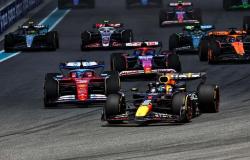The new regulatory revolution, power unit and aerodynamics of F1 is approaching with great strides. After the definition of the specifications relating to the second generation hybrid turbo units which took place in August of 2022i team have carried out simulations regarding their performance, using virtual models adhering to the current regulatory body. The result was disastrous, to the point of forcing the technical management of FIA to also completely revisit the aerodynamic and chassis part of the ground effect cars themselves.
The draft of the regulation that will govern the design of the aerodynamic features of future single-seaters will be released at the end of 2024. The manufacturers who have currently accepted the technological challenge are: Red Bull Powertrains (Ford, ed.), Mercedes, Ferrari, Honda, Renault And Audi. From the 2026 the thrusters will no longer make use of the complex energy recovery system MGU-H which provides its contribution in the acceleration phase by minimizing the so-called turbo lagi.e. the delay between pressing the accelerator and activation of the turbocharger.
How do current F1 power units work?
In the “full throttle” segments, the MGU-K transfers all the power produced by the engine to the wheelsMGU-H. The power flowing from the battery to theMGU-K is linked to the battery charging system, so that below a certain charge threshold of the energy store the power supplied to the battery is automatically “cut”.MGU-K. During the braking phase, part of the kinetic energy of the vehicle recovered and converted into electrical energy is delivered to the motion generator dedicated to the exhaust enthalpy to maintain the turbocharger unit at a set rotation speed, while the excess part is stored in the battery.
In the release phase, the energy necessary to maintain the turbocharger unit at a set rotation speed is taken from the energy store. The acceleration phase, after a release phase, is divided into two periods:
• In the first stage, as soon as the accelerator pedal is pressed, energy is taken from the battery to power the turbocharger unit. Once the reference speed is reached,MGU-H can receive energy from the turbocharger assembly.
• In the second phase I’MGU-H supplies electricity directly to theMGU-Kwhich helps accelerate the vehicle.
F1, how the second generation power units work?
The elimination ofMGU-H from the architecture of the new ones power unit is due to the limited possibility of replicating the complex system on road cars and above all due to the explicit will of the group Volkswagen who asked for its removal as an essential condition for Porsche And Audi did not suffer from a significant technological delay compared to other manufacturers already involved in F1. The loss ofMGU-H will be balanced by tripling the current power offered by theMGU-K going up to 350 kW (around 469 HP, ed.), which will bring the division between the internal combustion engine and electric energy to an equal contribution in terms of power.
Despite the FIA you say you are satisfied with the simulations of the new aerodynamic guise in terms of “dirty” flows towards the chasing car, you still believe it is essential that the active aerodynamic devices facilitate overtaking actions. The current DRS will continue to exist, in combination with other active aerodynamic devices, to modify the adjustment of the front and rear wings in a straight line. The side effect could consist of very low aerodynamic resistance, so much so that it allows very high speeds on straights which could make overtaking even more complicated. The federal body is confident that the DRS effect will be reduced compared to the current one.
Once the threshold of 340 km/h has been reached, the assistance of theMGU-K will progressively decrease, based on what is simulated together with the resistance profile of future single-seaters. Lower drag at high speed will allow for less electric power support. In this way, a dramatic situation should be avoided clipping of speed on the longest straights and subsequent deceleration, as observed in the simulations carried out by team using the current aerodynamic layout of single-seaters.
F1, the “Override” mode
The 2026 single-seaters will also be supported by an “Override” system that drivers can activate to benefit from more electric power. When manual override is activated, the MGU-K will continue to deliver a maximum power of 350 kW over 340 km/h up to 355 km/h. However, it has not been chosen how long this mode will last or how many times the driver will be able to use it over the course of a lap or the race. These aspects will be regulated in the sporting regulations, once the definitive rules on the chassis have been consolidated.
The introduction of this boost is part of a regulatory body that has failed to bring the pilot’s skill to the center show. Despite the regulatory revolutions of 2022 and the next one of 2026, the use of active aerodynamic devices is increasing, debasing the audacity of the pilots, making the show more artificially animated. This nevertheless the FIA believes that the combination of active aerodynamics and “Override” are the best solution.
He thinks of it in terms of matching the characteristics of the car and the engine, aspects which contribute to preserving the traditional skills of the driver, avoiding the danger that the F1 become a great automated exercise in energy-related manipulation power unit. Analyzing the geometry of the circuits another doubt arises spontaneously: with the exception of Monza And Baku, on which circuits speeds above 340 km/h are reached?
Author and images: Roberto Cecere – @robertofunoat – F1






